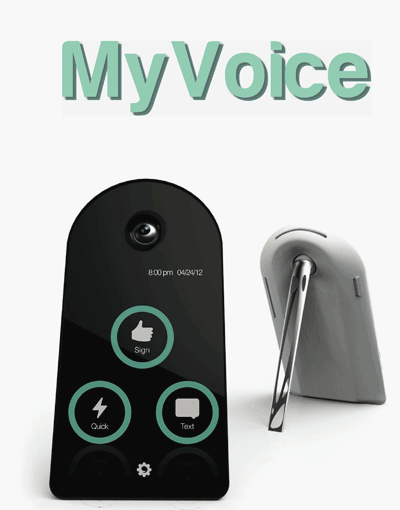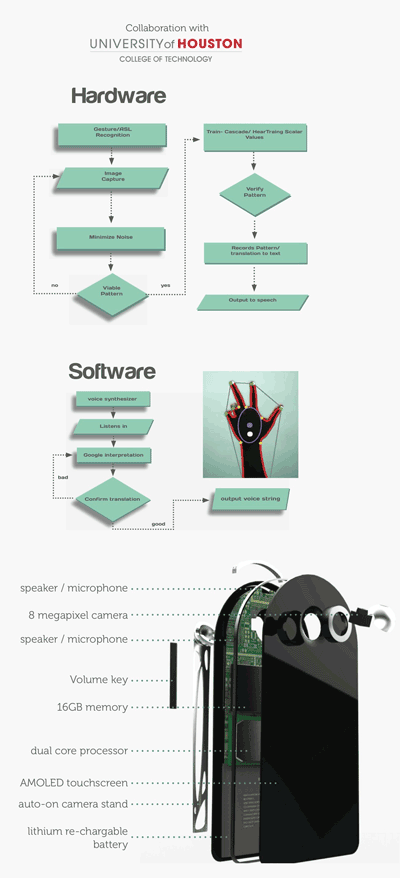Students create device that translates sign language
Technology helps overcome barrier between those who can hear and those who cannot
In a unique collaboration between departments, students in the University of Houston’s engineering, technology, and industrial design programs worked together to develop the concept and prototype for MyVoice , a device that has the ability to read sign language and translate movement into audible words.

MyVoice has the ability to translate sign language into spoken / written word.
The device earned first place honors among student projects at the American Society of Engineering Education’s Gulf Southwest Annual Conference.
Farrokh Attarzadeh, associate professor of engineering technology, and EunSook Kwon, director of the University of Houston’s industrial design program, oversaw engineering technology students Anthony Tran, Jeffrey Seto, Omar Gonzalez, and Alan Tran, and industrial design students Rick Salinas, Sergio Alemen, Ya-Han Chen, as they worked together to create this exciting new device that allows those not fluent in sign language motions and hand shapes to better understand the language of the deaf community.
How it works
MyVoice is a handheld tool that consists of a built-in microphone, speaker, soundboard, video camera, and monitor.

The hardware behind MyVoice. The idea is to be able to place it on a surface where it can watch a person’s sign language motions. MyVoice then processes these movements before translating and speaking their meaning out loud in an electronic voice.
To facilitate back-and-forth conversations, MyVoice can also record a person’s voice and translate the words into sign language by projecting hand motions on the device’s monitor.
“The biggest difficulty was sampling together a database of images of the sign languages. It involved 200 to 300 images per sign,” Seto said. “The team was ecstatic when the prototype came together.”

Sign language alphabet chart is a small sample of the thousands of images that the students needed to demonstrate and record. (Via: iidc.indiana.edu)
Custom tailored to meet the needs of the community
While the engineering technology students were in charge of building and programming MyVoice, the industrial designers did a lot of leg work in determining how the device would best be applied within the deaf community. They reached out to members of this group to understand the challenges that come with trying to communicate with those who do not understand their language.
Based upon the data gathered, the group then set out and designed MyVoice.
“This wasn’t just a project we did for a grade,” said Aleman. “While designing and developing it, it turned into something very personal. When we got to know members of the deaf community and really understood their challenges, it made this MyVoice very important to all of us.”

MyVoice is specially designed to address the concerns of the deaf community.
Video
This short video shows a demonstration of MyVoice. It’s particularly impressive how quick the device responds to the user’s motion:
Outlook
Since MyVoice was created and the team brought home first place honors at the ASEE conference, all of the students involved on the project have graduated. Aleman assures those concerned with the project’s status that just because they’re done with school, MyVoice isn’t finished.
“We got it to work, but we hope to work with someone to implement this as a product,” Aleman said. “We want to prove to the community that this will work for the hearing impaired.” ■
Advertisement
Learn more about Electronic Products Magazine





